Shortcut Keys
| N | New Game – Draws a new random deal. |
| R | Replay Deal – Restarts the current deal. |
| L | Select Layout – Enables the selection of layout, difficulty level, and the deal number, as well as the ability to check statistics. |
| O | Options – Select background, tile shape and color, and glyph styles, as well as other options (like, for example, playing sounds). |
| A | About Mahjong – Opens this window. |
| Z | Undo – Reverses the latest move. |
| Ctrl+Z | Undo – Reverses the latest move. |
| H | Hint – Highlight two tiles that can be removed in the next move, as long as such tiles exist. |
| S | Shuffle – Randomizes the locations of tiles that have not yet been removed from the board. |
| D | Rotate – Changes the direction/isometric view of the board. |
| Esc | Close – Closes the dialogue box or drop-down menu that is currently open. |
| Up | Press to select the previous layout in the Select Layout dialogue box. |
| Down | Press to select the subsequent layout in the Select Layout dialogue box. |
Mahjong
Welcome to Mahjong Solitaire Online! Mahjong is an Ancient Chinese matching game that has grown to become popular all over the world. Thank you so much for choosing our game and playing with us. Have fun!
Overview
Traditionally, Mahjong (or alternatively, Mah-jongg) is a multiplayer game that is popular in East Asia. It is commonly played by four players, has 144 game pieces (tiles) and is sometimes involved in gambling. However, for the purposes of making a video game, the multiplayer game has been modified into Mahjong Solitaire, a game that is played by one player, which - despite using the exact same tiles as the original version - has completely different rules. The objective of Mahjong Solitaire is to remove all tiles from the board, according to specific rules. In fact, this Solitaire game became so popular that it is often associated with the name “Mahjong” instead of the original Chinese version, especially in the West. In the East, the game is known under different names, such as “Shanghai” in Japan.
Mahjong Rules
The objective of the game is to disassemble a pile of game pieces (tiles). There are 144 tiles, which can be removed in pairs. In order to remove a pair of tiles, a number of conditions have to be met. First of all, the tiles need to belong to the same category. In most cases, this means that the tiles need to have the same picture on them, but there are a few exceptions to this. Also, the tiles cannot be blocked from the sides, and there cannot be other tiles on top of them. In other words, in order to remove a tile, you should be able to slide it left or right without disturbing other tiles. If a tile has an adjacent tile located upwards or downwards from it, it still can be removed.
Each tile category contains 4 tiles, and there are 36 categories in total. These categories can be further divided into themes. The first three themes have 9 categories each. Tiles in these categories can be identified by a number and a theme. The first theme is chains or bamboo. The tiles in these categories can be identified by a number (from 2 to 9) of elongated shapes that are drawn on them. Instead of 1 chain (or bamboo), the illustration on the tile often depicts a bird. The second theme is barrels (or coins). These tiles can be identified by the number (from 1 to 9) of circle-shaped objects on them. The third theme is legions. These contain a Chinese number (from 1 to 9) and a Chinese character for a legion (as in a very large number of something). The fourth theme is winds, and contains four categories: East Wind, West Wind, North Wind, and South Wind, each of which is identified by an appropriate Chinese character describing the geographic direction. The fifth theme is dragons. Again, we have three categories: Red Dragon, Green Dragon, and White Dragon. So far, all of the mentioned categories consist of four identical tiles. But here is where things start to change: the remaining two categories sometimes have different pictures on the tiles, thus complicating the task of finding matching pairs. The remaining two categories (which can be bundled together under the theme of nature) are seasons and plants. Naturally, the seasons include Spring, Summer, Fall, and Winter. Plants, on the other hand, include Plum, Orchid, Chrysanthemum, and Bamboo.
It is important to remove tiles in such an order as to not get stuck. Whenever you have four tiles that belong to the same category available for removal, you can safely remove them in any order. However, if you have only two or three tiles currently available for removal, then you need to be careful – because if you remove the wrong two, you can get easily stuck. One example is a situation in which there are two tiles belonging to the same category stacked on top of each other. If you remove the other two tiles from this category, then you will get stuck, because there is no way to remove the remaining two, as the bottom one is being blocked by the top one. In order to avoid this situation, try and pay attention to where all of the tiles belonging to a certain category are. Another piece of advice is to remove the tiles that unlock other tiles first – this way, you will have more available options and you can reduce your chances of getting stuck.
Fortunately, the game has a lot of features that will help you, even if you make a mistake. First of all, there is an option that you can use to undo your last move if you make a mistake. There is also a hint which indicates the pairs of tiles available for removal. The number of moves (that is, the pairs currently available for removal) is shown in the status bar at the top of the screen. When this number drops down to zero, this means that you have either won the game by removing all tiles, or you have lost and there are no more pairs available for removal. In this latter case, you can shuffle the board and rearrange the tiles randomly. Finally, there is also an option to rotate the board. Now, you will see the tiles from a different angle. This does not affect the gameplay, only the visual aspect of the game.
The game also features a lot of customizable options. Advanced players can disable the above-mentioned undo, hint, and shuffle features if they like. The number of moves available that is shown by default in the status bar at the top of the screen can be hidden. The same can also be done to the tile names that are displayed nearby. Also, by default, hovering the mouse over a tile that is not blocked will highlight it. This can be turned off, though, if the player wishes. There is also an option to turn the sound off/on.
There are multiple options pertaining to the game’s visual settings. First, the player has a choice of four backgrounds, including blue, green, purple carpet-like backgrounds, and a solid light gray one. The tiles come in five varieties: Beige, Cedar, Gold, Pale, and White. Out of these five options, the first four allow for various tail-side colors, namely blue, green, and red. White tiles are entirely white, and their tail-sides cannot be changed. Finally, player can also select one of the four set of pictures (glyphs) to be displayed on top of the tiles. The default glyphs have the highest contrast. Glyphs made by FluffyStuff have a little bit of a tone to them. For someone who is interested in pale colors, there is also the Gentle glyph set. Contours glyphs are in plain black and white.
The traditional tile layout, sometimes also known as “The Turtle”, is just one of the many layouts that are available. This online Mahjong Solitaire has over sixty different layouts, with each one available in different difficulties. The easier it is to get stuck, the more difficult the game becomes. There are 11 basic difficulty levels. First, there is the traditional difficulty. Upon choosing this option, the player faces a pile of tiles that are randomly arranged. Depending on the layout, this can prove to be very easy or very hard to solve. The absolute difficulty of the traditional mode is indicated by the number from 1 to 10 in the “Select Layout” window. An important thing to note is that with traditional difficulty, games are sometimes unsolvable; that is to say, for some random arrangements of tiles, you will simply get stuck no matter what you do. Alternatively, you can choose one of the 10 solvable difficulty levels. In these difficulty levels, arrangements of tiles are proven to be solvable, and there exists some combination of moves which can result in the removal of all tiles. If you choose difficulty 1, you are the least likely to get stuck; whereas if you choose difficulty 10, it will be almost impossible not to get stuck. Because some layouts are inherently easier to solve, it is impossible to find difficult arrangements of tiles in them. Similarly, some layouts are inherently hard, and so it is not possible to find easy arrangements of tiles for them. In these cases, certain difficulty levels are disabled.
You can always go back to a difficult tile arrangement that you previously failed to solve. All you need to do is remember its deal number. For a given layout and difficulty, the deal number tells you how tiles are arranged on the board.
There is no scoring system in this online Mahjong game. However, the game does keep track of how many games you have played, how many times you have won, and how much time you spent playing. These statistics are kept at the difficulty, layout, and global levels. The game also keeps track of how many layouts and which difficulties you have beaten and displays your overall progress. This way, you will know once you have beaten all layouts and all difficulties. We sincerely wish you good luck in accomplishing this!
How to play Mahjong: solving example
In the following example, we are going to solve the traditional Turtle layout. The descriptions include a few basic strategies which should help you to get started with the game. Note that this is not an example of an optimal game.
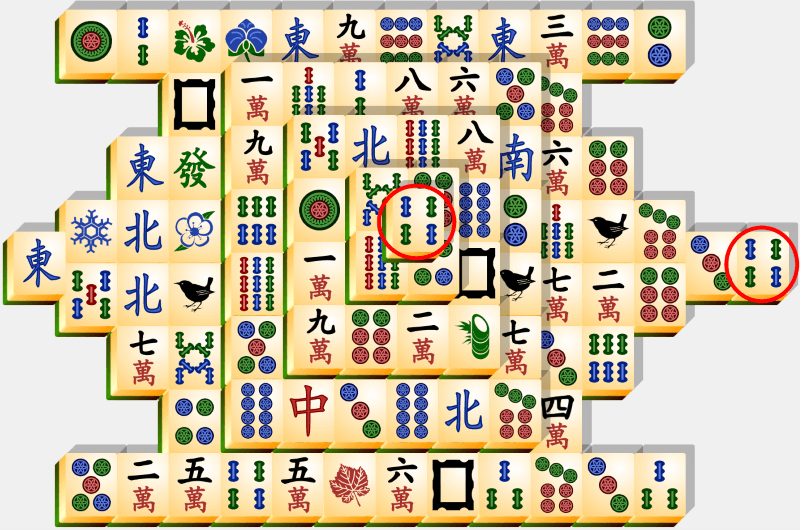 Our priority is to make as many tiles available for removal as possible. The tile at the top of the pile is especially important, because it locks four tiles beneath it. The right-most and the left-most tiles are also important. In this deal, we are fortunate, because we can remove two of those in the first move. There are 4 chains at the top of the pile and on the right, both marked with a red circle. Now, let’s click on them to remove them. |
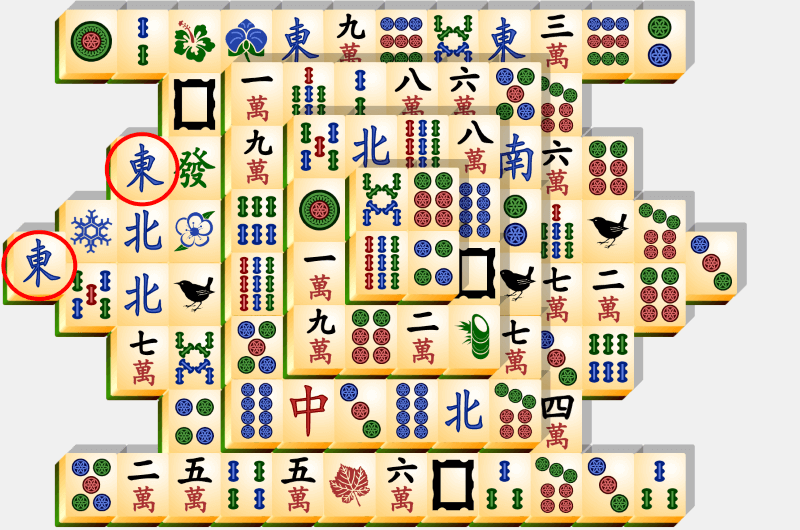 Next, we can move to our other priority – the left-most tile. This is the East Wind tile. We can easily see another East Wind close by. Let’s remove them both. |
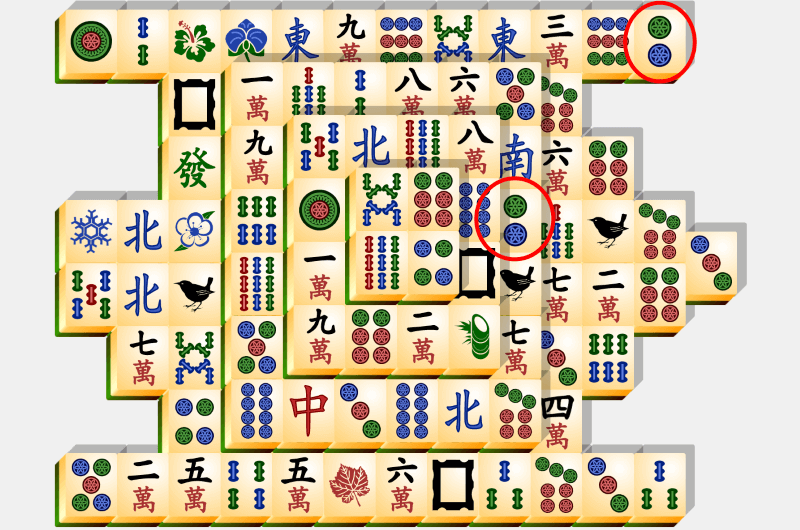 Another priority is to identify longest rows of tiles and then make them shorter. We want the rows to be as short as possible, so that the fewest tiles are trapped in them. This is why we can now focus on the top-most row and remove the 2 barrels from it by matching it with another 2 barrels. Both of them are marked with red circles. |
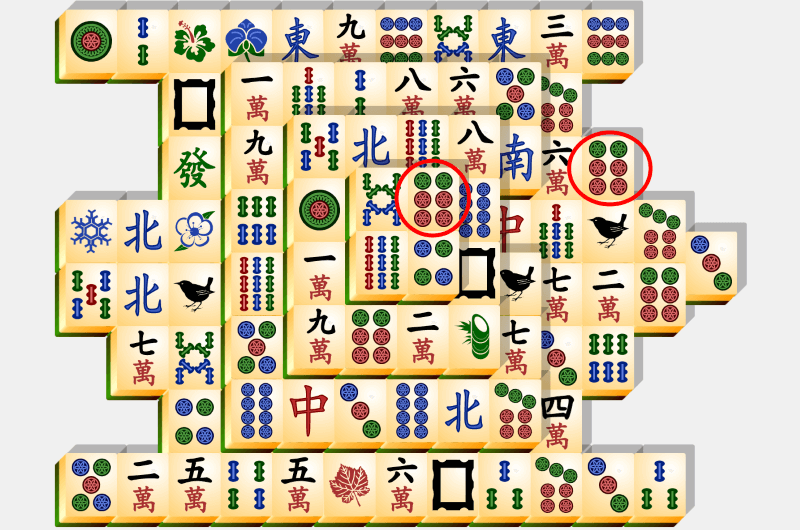 Currently, the best move would be to remove the 3 barrels, which is the right-most tile of the pile. However, there are no tiles available for us to remove it with. And so, we can casually continue to disassemble the pile, hoping that the 3 barrels will eventually emerge. This time, we’re going to remove 6 barrels, marked with red circles. |
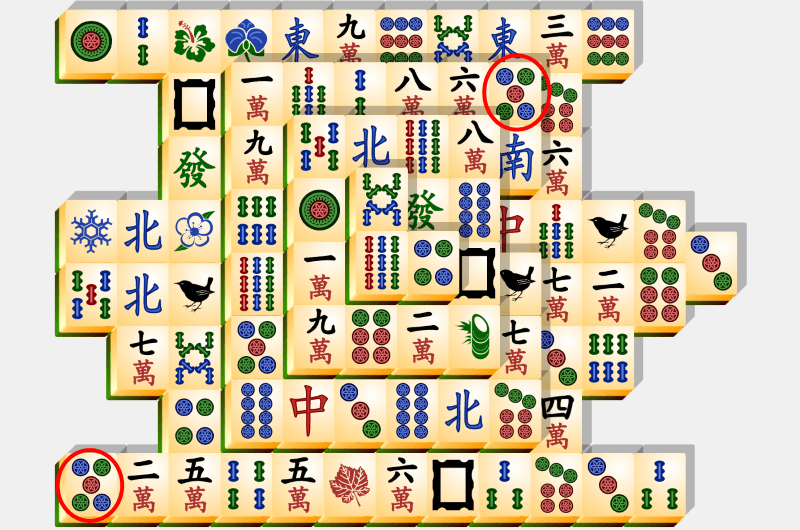 Like we did previously, in an effort to shorten the longest rows, let’s remove the 5 barrels from the last row. We’ll choose the upper 5 barrels to match it with, because it makes the adjacent 6 legions available, while the lower 5 barrels would make nothing new available. |
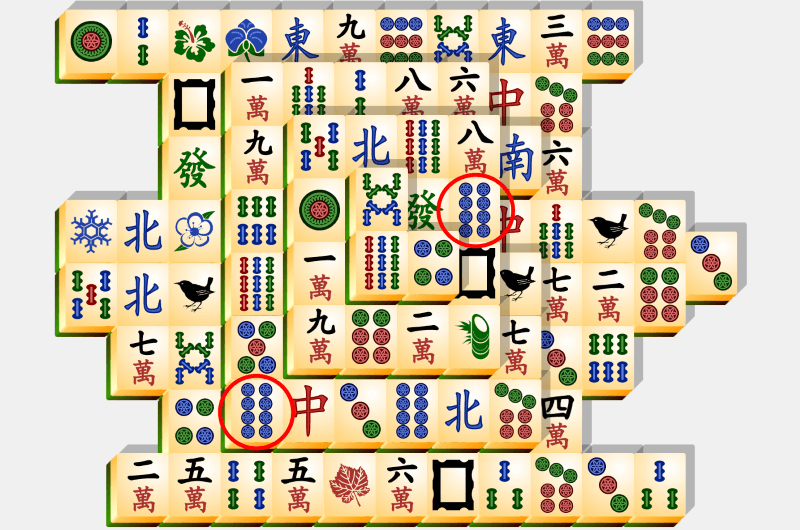 Here, we remove the 8 barrels and make the Red Dragon and the Green Dragon available. Why? Our objective is to remove the right-most 3 barrels. In order to do that, we are going to need to make another 3 barrels available. |
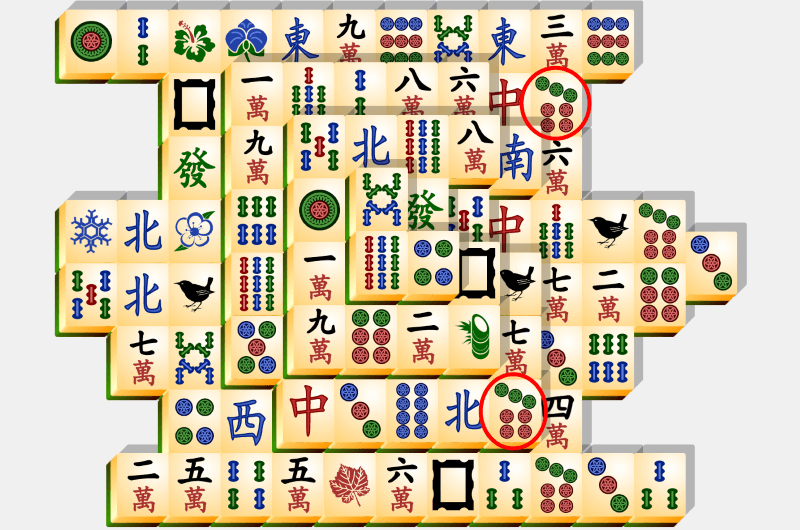 Let’s remove the 7 barrels to make another Red Dragon and the North Wind available. |
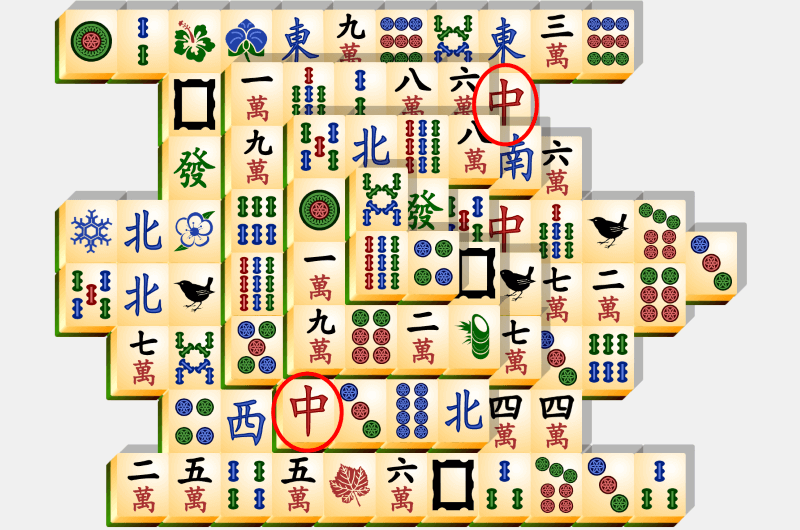 Now that we have two Red Dragons available, let’s remove them so that we can finally get rid of the right-most 3 barrels. |
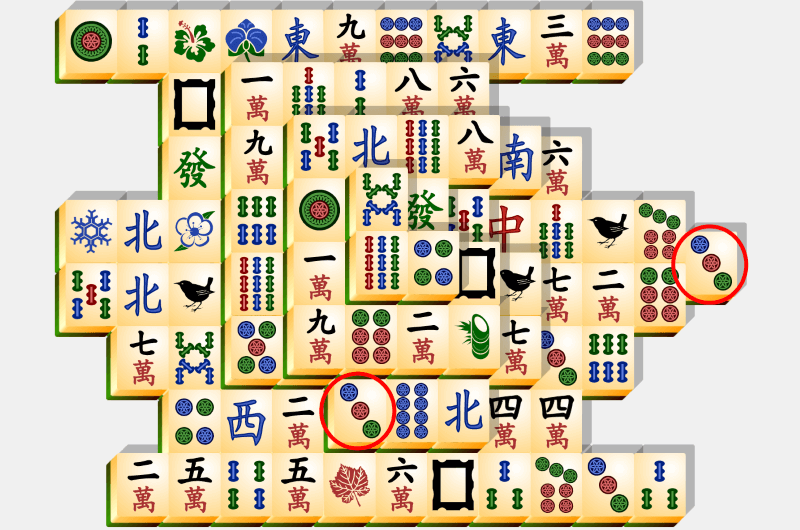 Yes! We can now remove the right-most 3 barrels. Our objective has been completed! |
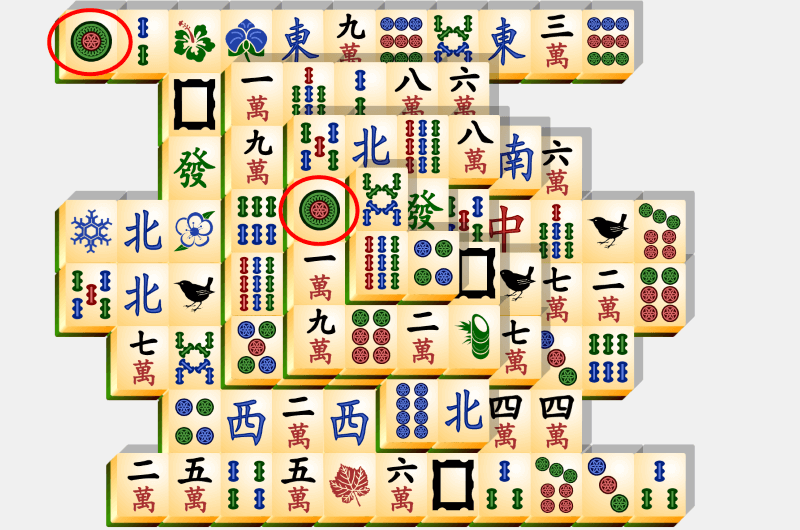 Let’s remove the 1 barrel from the top-most row. We don’t want our longest rows to be too long. |
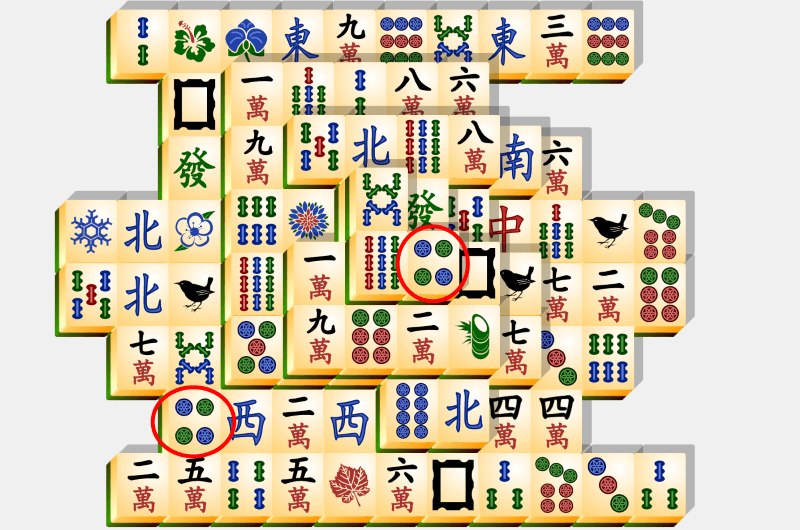 Now, let’s remove 4 barrels from the top of the pile. We don’t want our pile to be too tall. |
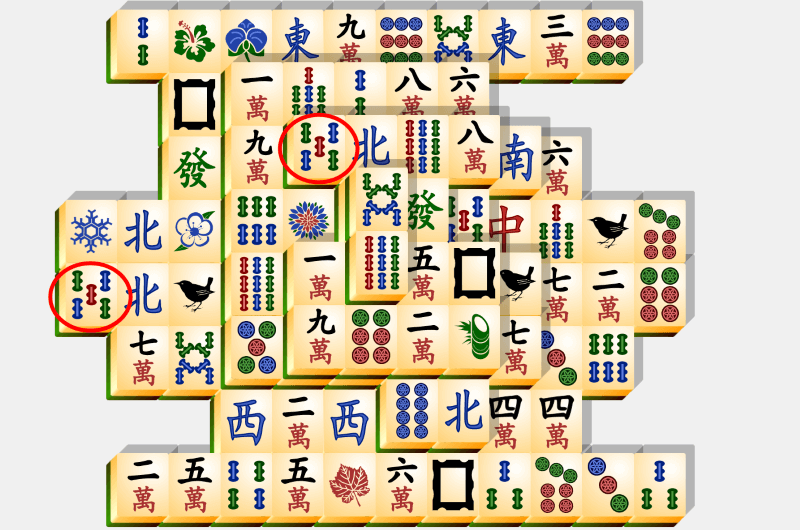 Next, it’s time to remove 5 chains. Why? No particular reason. There are so many moves available to us at this point that we simply pick the first one that comes to mind. Be sure to note, however, that the removal of these tiles makes two other tiles available – two North Winds. |
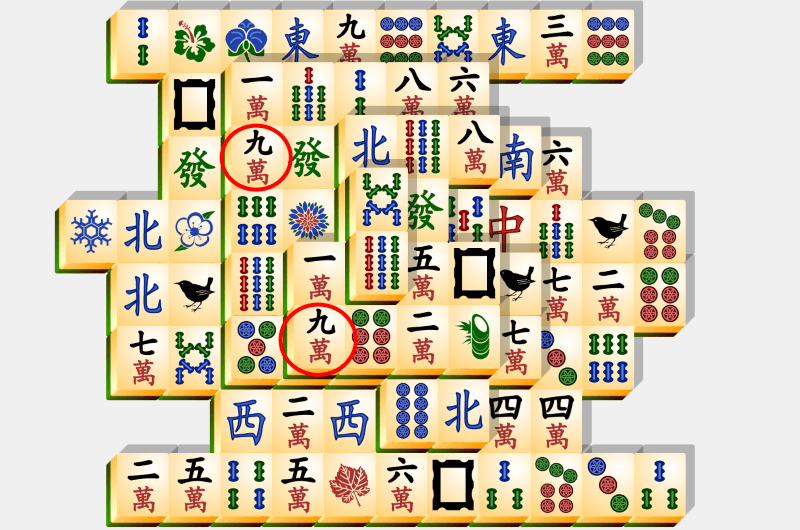 Continue to casually dismantle the pile: remove the 9 legions. |
 Remove the 7 legions. |
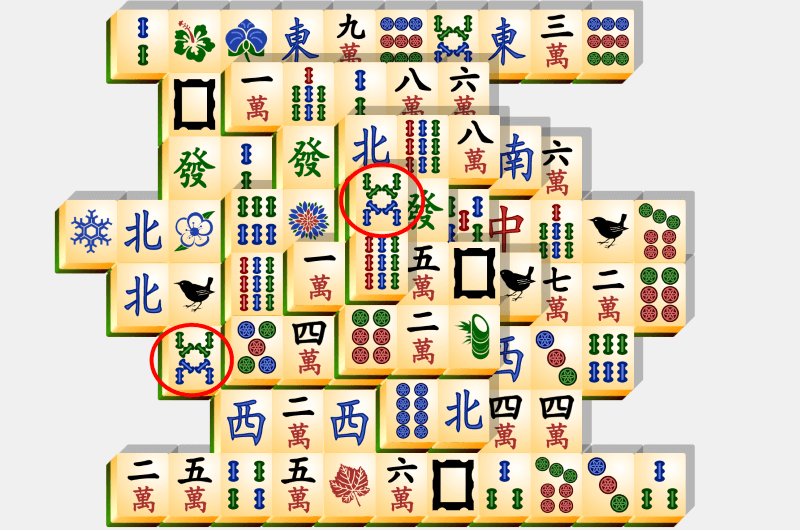 Remove the 8 chains. |
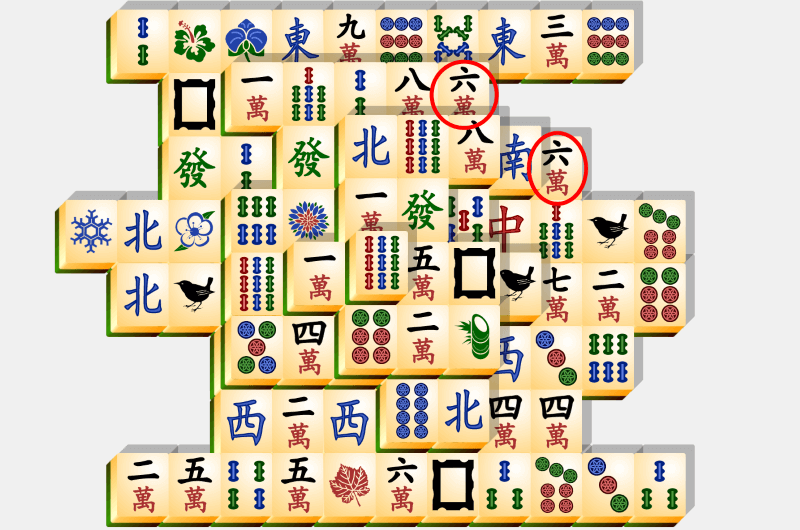 Remove the 6 legions. |
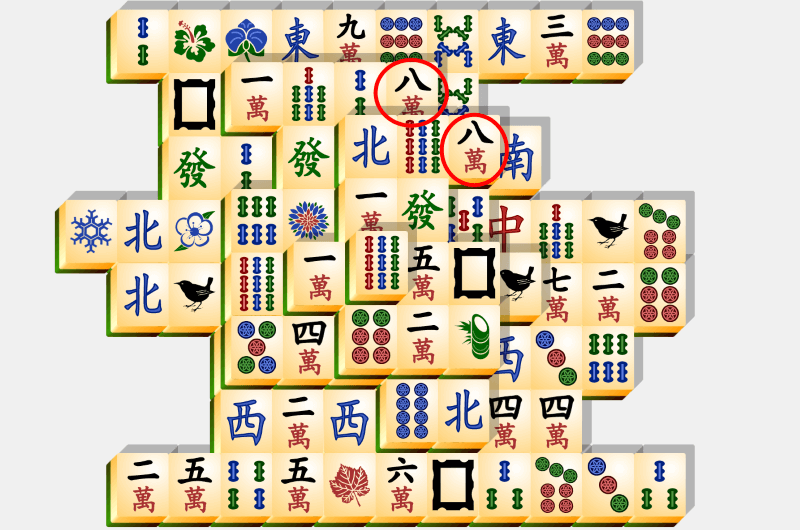 Remove the 8 legions. |
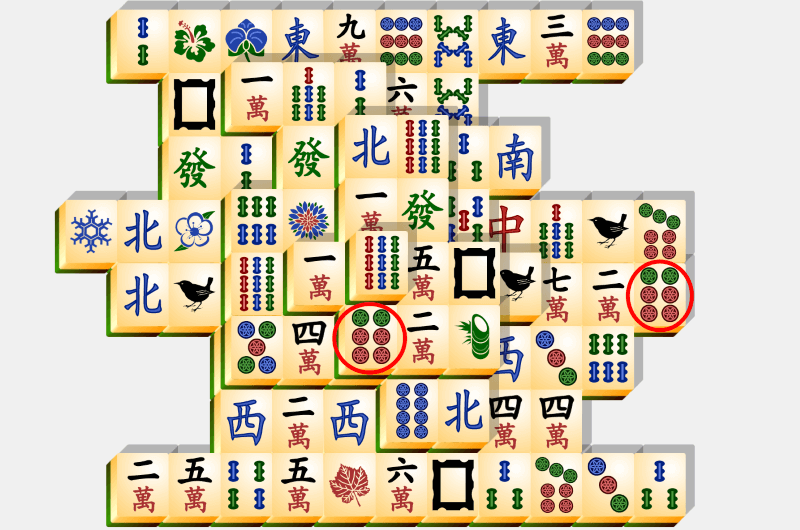 Remove the 6 barrels. This is a good move because not only does it work to shorten a very long row, it also removes a tile from an upper layer of the pile. |
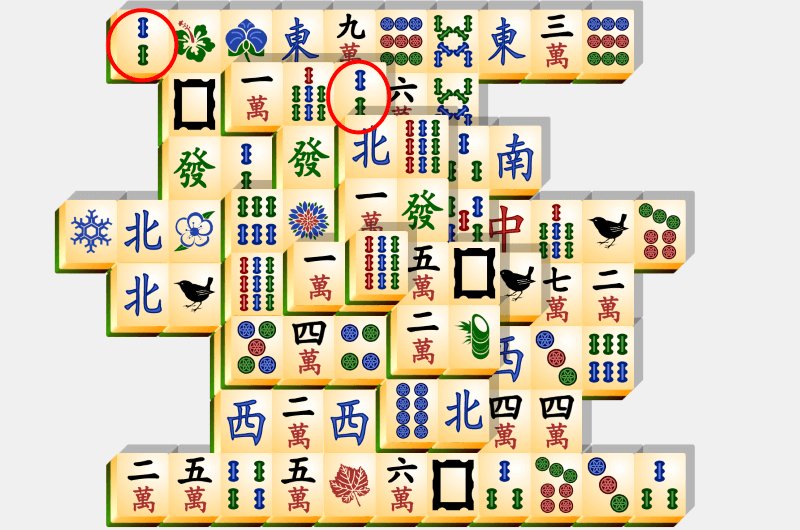 Now, we can remove the 2 chains. Removing the upper layers of the pile is important, because a common way to get stuck is to have the same tiles stacked on top of each other. If the highest layers have been removed, then this is going to be impossible. However, we cannot mess around too much with the removal of higher layers, because having higher layers provides us with more available tiles and a better choice when it comes to their removal. Therefore, the speed with which we remove the upper layers must be quick, but not too quick. |
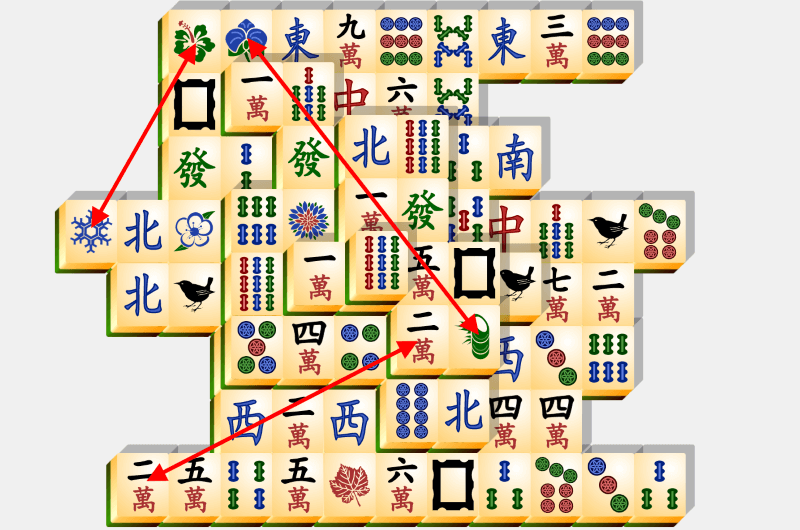 Okay, now let’s process three moves at a time. We remove the Winter and the Spring as the first pair. Then, we remove the Orchid and the Bamboo as the second pair. And finally, we remove the 2 legions. |
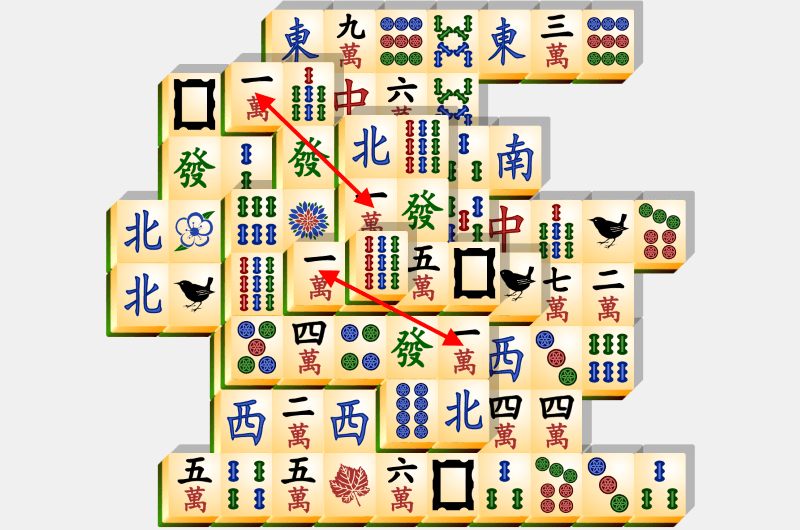 Notice that all four 1 legion tiles are available. Whenever there are four tiles available, we can remove them immediately without thinking, because there is no way that we can get stuck by removing them. Getting stuck can only result from removing tiles in the wrong order. And when all four are available simultaneously, there is no way we can get the order wrong. |
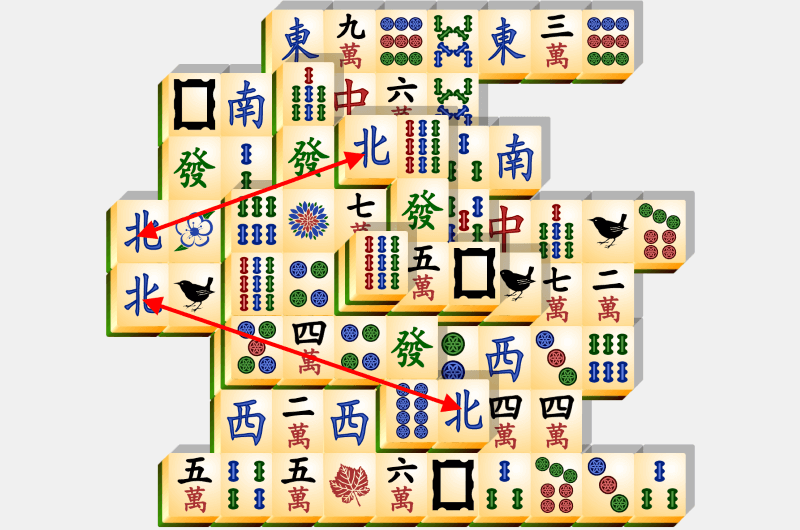 Same here. All four North Wind tiles are now available. We can safely remove all of them. |
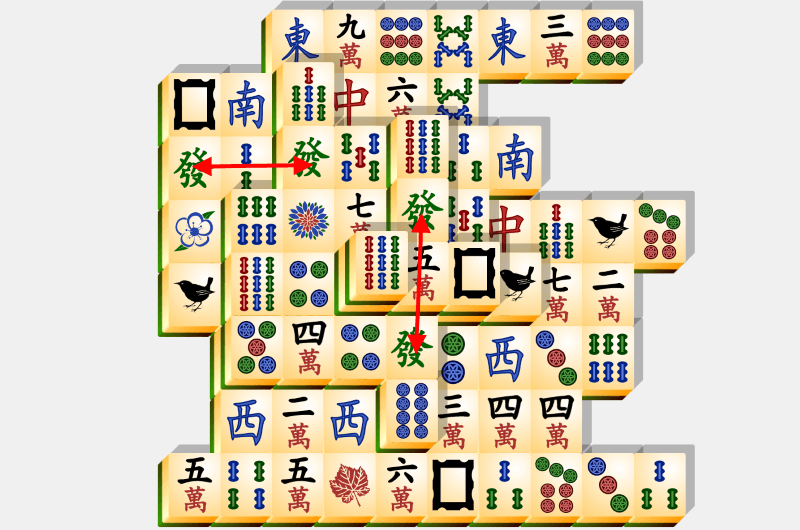 And again. Four Green Dragons available. Let’s remove them. |
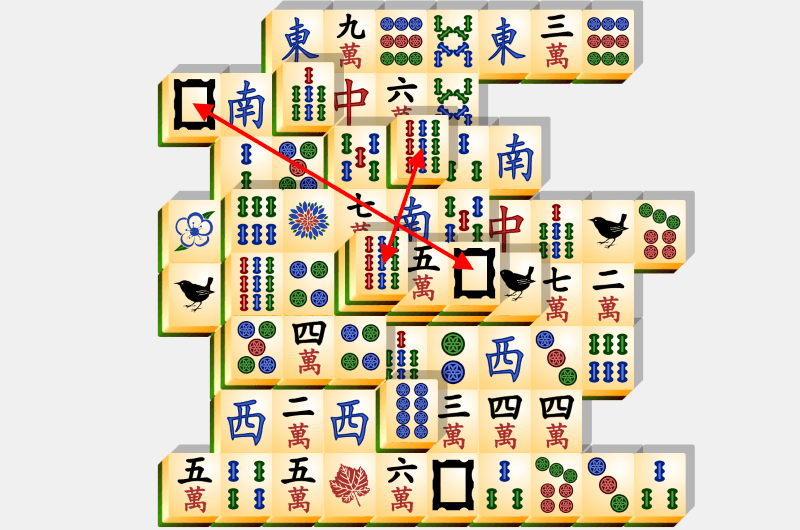 Now, the top-most tile is the 9 chains tile. Let’s remove it. Let’s also remove the White Dragon. |
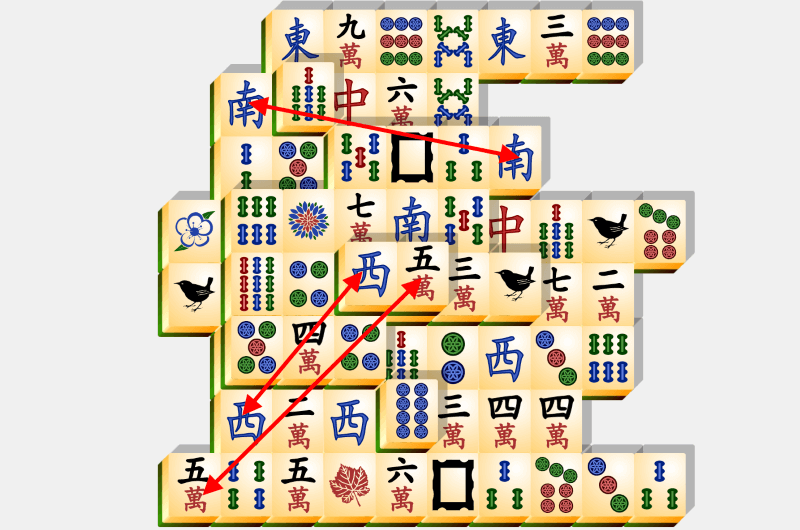 Let’s get rid of the two top-most tiles: the West Wind and the 5 legions. We can also remove the South Wind. |
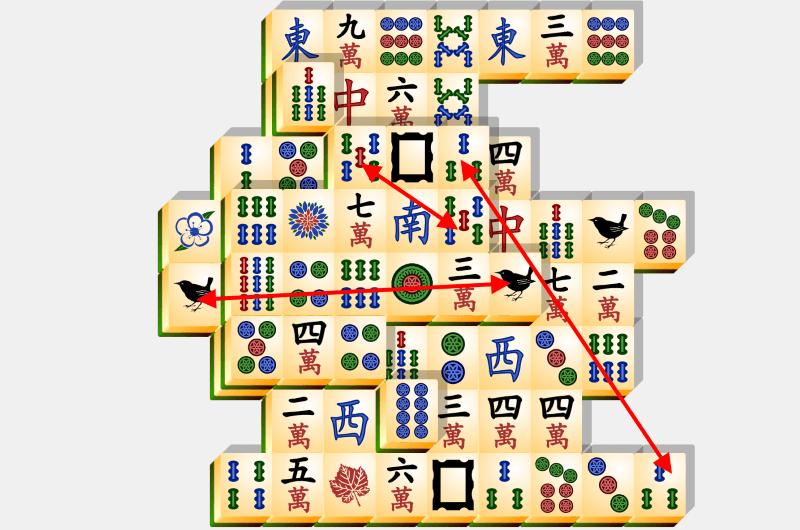 We continue to employ our previous strategies by removing the 3 chains in order to reduce a lengthy row, as well as by removing the 5 chains and 1 chain to reduce the size of the second layer. |
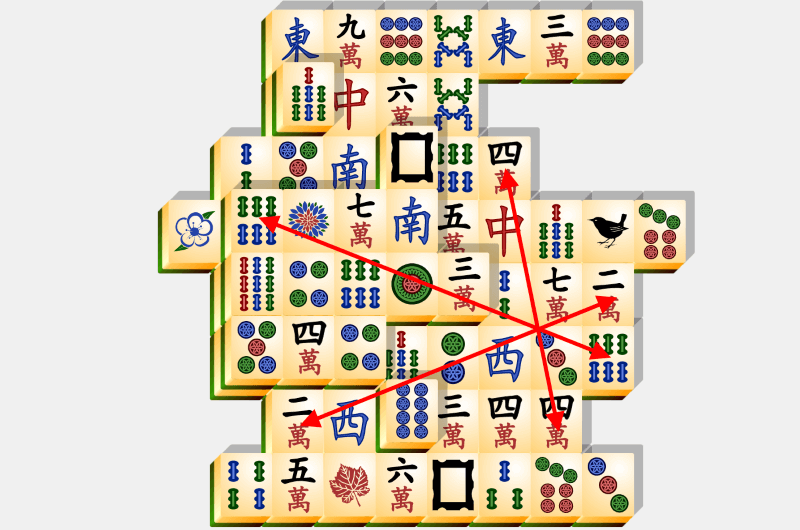 It is wise to remove the 4 legions now. Notice that there is a twin pair of them next to each other. If we remove the other two together, then we may get stuck, as the two next to each other have a potential to block our moves. Therefore, we remove one of the twins with another 4 legions above. We also remove the 2 legions and the 6 chains. |
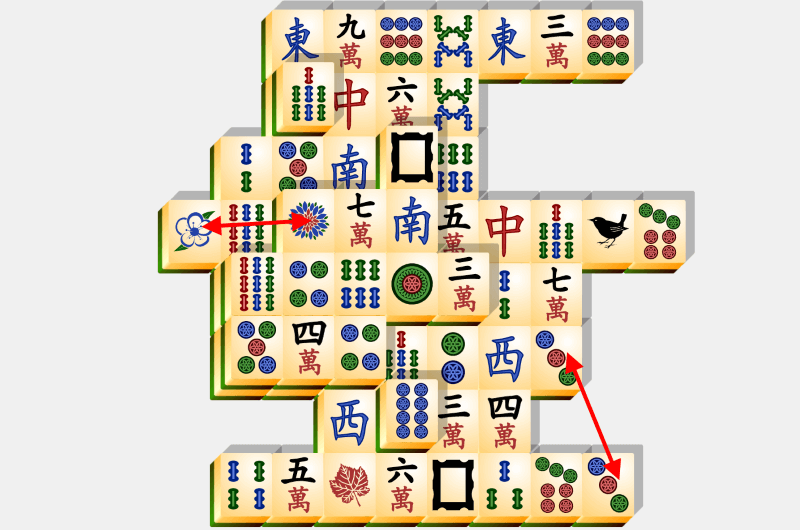 Now, let’s remove the 3 barrels, as they are both in quite long rows. Let’s also remove the Plum and the Chrysanthemum. |
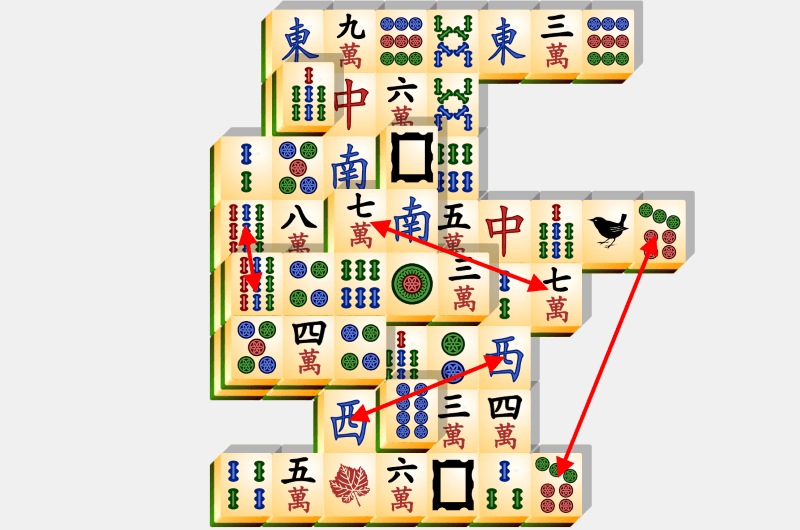 This time, we are making four moves at the same time. First, we’ll remove the 7 barrels, shortening the longest row. Then, we’ll remove the 7 legions and the 9 chains, also shortening long rows, along with reducing the number of tiles in the second layer. Finally, we’ll remove the West Wind. |
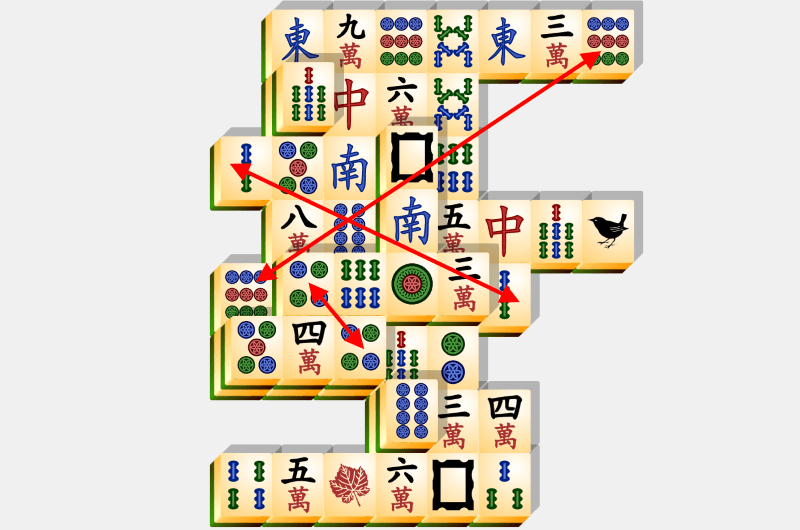 Let’s remove the 4 barrels, the 9 barrels and the 2 chains. |
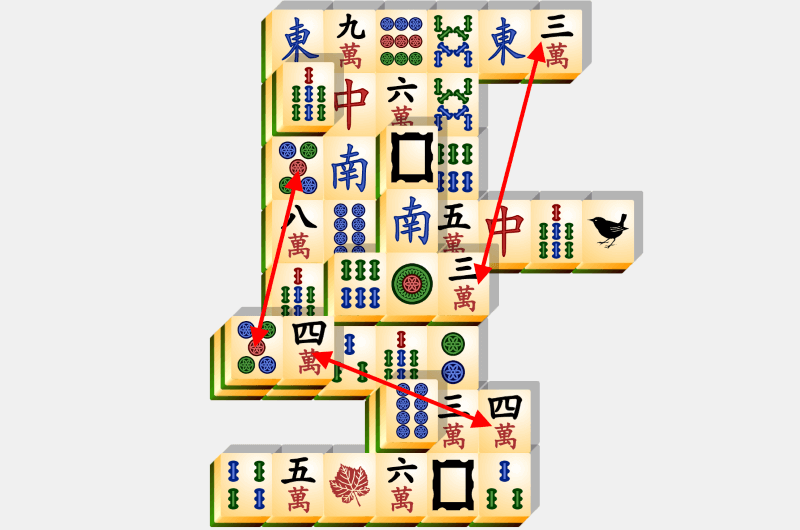 At this stage, we are becoming optimistic that a win is within our reach. There are not many tiles left on the board. Let’s remove the 5 barrels, the 4 legions, and the 3 legions. |
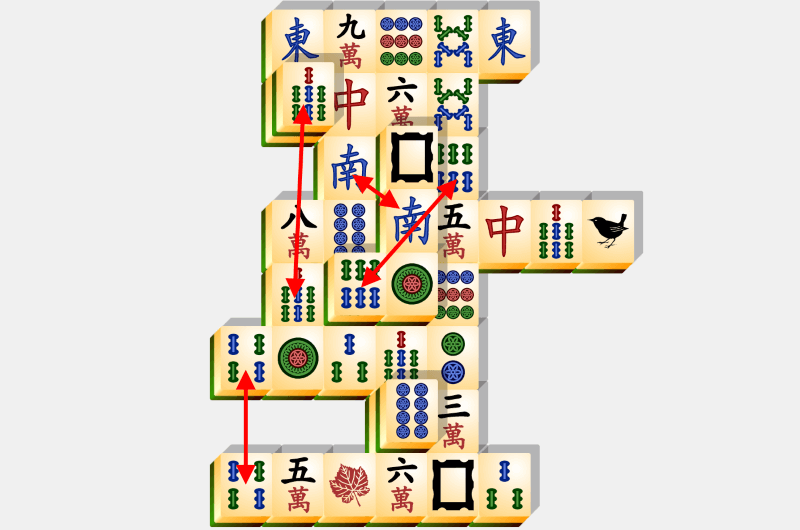 Here, we continue to shorten rows and remove the second layer. Now, let’s go with the 7 chains, the 4 chains, the 6 chains, and the South Wind. |
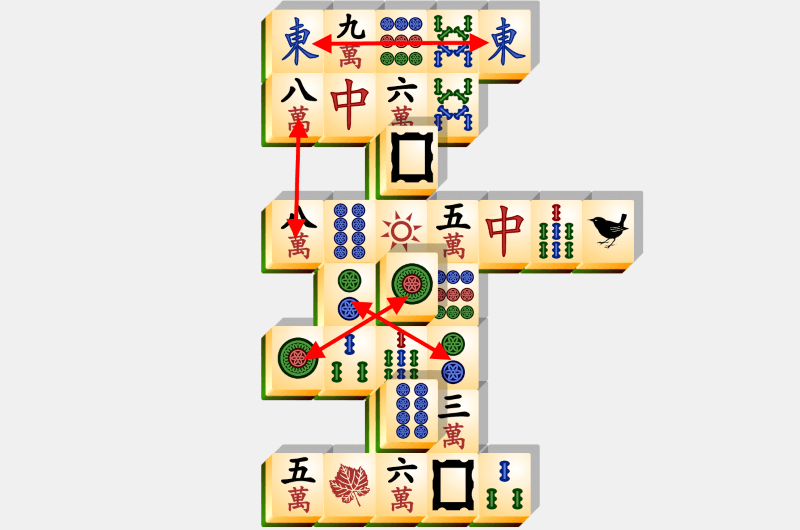 Very few tiles remain on the board, and we still have so many moves! Success is getting closer and closer. Let’s remove the 1 barrel, the 2 barrels, the 8 legions, and the East Wind. |
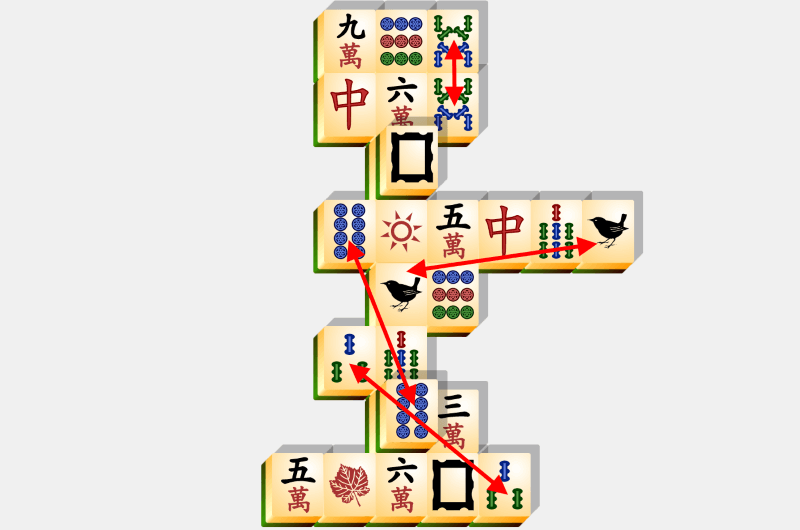 Shortening the longest rows and removal of the second layer: let’s get the 8 barrels, the 3 chains, the 1 chain, and the 8 chains. |
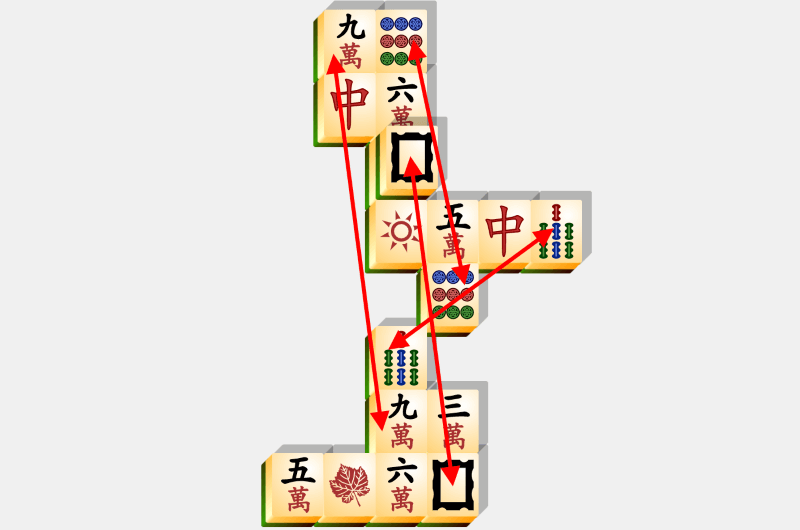 We can finally get rid of the second layer once and for all! Let’s remove the White Dragon. Let’s also remove the 9 legions, the 9 barrels and the 7 chains. |
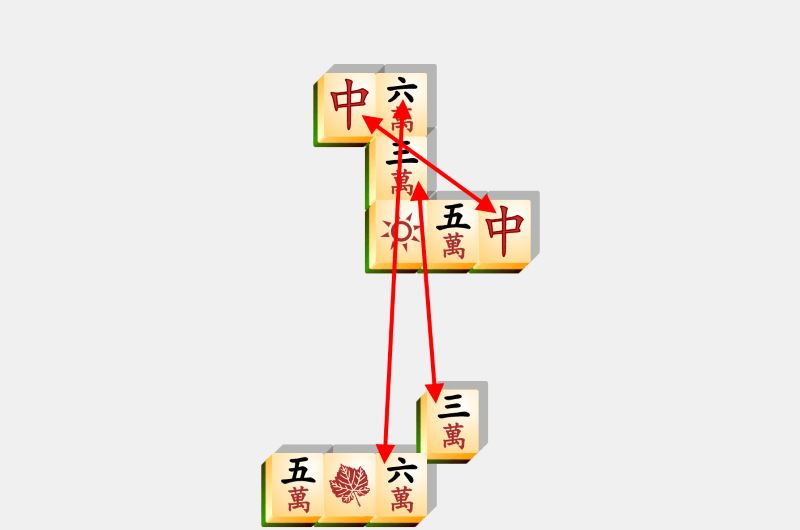 There are now so few tiles left on the board that we are almost certain to win. Remove the Red Dragon, the 3 legions, and the 6 legions. |
 And now we know for certain that we have won. The last two pairs to be removed are the 5 legions and the Summer and the Fall. Congratulations! |
History
Mahjong first originated in China in the Eighteenth and Nineteenth Centuries as a mostly four-player gambling game (similar to Poker). Initially, coins were used to play it with, instead of tiles. The pictures on the modern sets that resemble circles and are called “barrels” were meant to depict coins, back in the old days. The chains were meant to depict multiple coins on a string. Finally, legions (or myriads) referred to a large number of coins. However, this original meaning has been lost over time. The game was banned in China during the Cultural Revolution, and was otherwise generally discouraged due to a ban on gambling. Currently, it is one of the favorite pastimes in China.
The original Mahjong was discovered by Westerners in the final years of the Nineteenth Century. It was imported to the USA in 1920, where it immediately became quite popular under the name “Mah-Jongg”. Currently, tournaments are being hosted all across the USA. The game is also a very popular table game in Japan.
However, all of this history pertains to the original version of Mahjong. Mahjong Solitaire was created in 1981 as a video game. The reason it was named “Mahjong” is that it uses the same tiles as the original Chinese game does. However, the rules are completely different. Most importantly, the original Mahjong is never played by one player, and Mahjong Solitaire always is. Additionally, since its inception, Mahjong Solitaire was mostly played on computers, whereas the original game was played using physical tiles and a table.
The popularity of Mahjong Solitaire is mostly due to the game “Shanghai”, which was released by Activision in 1986. The game was also included in many Microsoft Windows releases, most notably as “Mahjong Titans” with Windows 7 and “Shanghai Solitaire” with Windows Vista. Currently, the game still remains highly popular.
Copyright © 2021-2025 simiade.com. All rights reserved. | Terms and Conditions | Privacy Policy
